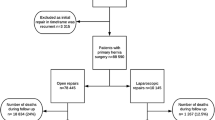Abstract
Background
Asymptomatic contralateral inguinal hernias are often present during initial inguinal hernia repair. Data on long-term results and progression to symptomaticity are sparse. The purpose of this study was to assess long-term rates and risk factors for contralateral inguinal hernia repair following unilateral inguinal hernia repair.
Methods
Using New York Statewide Planning and Research Collaborative administrative data, 32,384 adults who underwent initial inguinal hernia repair during 2002–2003 in New York State and achieved 10-year follow-up were identified. ICD-9 and CPT codes were used to identify patients. Patients were followed for 10 years subsequent to their operation to assess for contralateral repair. Those who did not achieve 10-year follow-up were excluded. Risk factors were compared using descriptive univariate statistics. Significant variables were then analyzed via multivariate regression models.
Results
For adult patients having primary unilateral hernia repair, 3364 patients (6.73 %) had contralateral repair during the follow-up period. After excluding “loss of follow-up” patients, the contralateral repair rate was 10.8 %. Contralateral hernia repairs first occurred at a mean of 3.9 ± 3.5 years and a median of 2.5 years after the initial surgery. Risk factors included age >45 years (OR 1.7 [1.4–2.0], p < 0.001), male gender (OR 2.2 [1.9–2.6], p < 0.0001), and white race (OR 1.6 [1.1–2.4], p < 0.001). Factors associated with decreased likelihood for repair included: congestive heart failure (OR 0.6 [0.4–0.9], p = 0.01), diabetes (OR 0.7 [0.5–0.8], p = 0.02), neurological disorders (OR 0.6 [0.4–0.9], p = 0.02), obesity (OR 0.3 [0.1–0.8], p = 0.01), and alcohol abuse (OR 0.2 [0.03–0.8], p = 0.03).
Conclusion
The 10-year probability of necessitating a contralateral inguinal hernia repair is significant. Elderly white males were more likely to undergo repair. Those less likely to undergo repair had significant comorbid conditions, possibly due to their poor suitability for intervention. These data highlight a key benefit of the laparoscopic approach over open repairs. Based on these data, an argument for laparoscopy with routine contralateral inspection in higher-risk patients can be made.

Similar content being viewed by others
References
Bay-Nielsen M, Kehlet H, Strand L, Malmstrøm J, Andersen FH, Wara P, Juul P, Callesen T, Danish Hernia Database Collaboration (2001) Quality assessment of 26,304 herniorrhaphies in Denmark: a prospective nationwide study. Lancet 358:1124
Bochkarev B, Ringley C, Vitamvas M, Oleynikov D (2007) Bilateral laparoscopic inguinal hernia repair in patients with occult contralateral inguinal defects. Surg Endosc 21:734–736
Burcharth J (2014) The epidemiology and risk factors for recurrence after inguinal hernia surgery. Dan Med J 61:5
Callesen T, Bech K, Kehlet H (1999) Prospective study of chronic pain after groin hernia repair. Br J Surg 86:1528–1531
Clark JJ, Limm W, Wong LL (2011) What is the likelihood of requiring contralateral inguinal hernia repair after unilateral hernia repair? Am J Surg 202:754–757
Eklund AS, Montgomery AK, Rasmussen IC, Sandbue RP, Bergkvist LA, Rudberg CR (2009) Low recurrence rate after laparoscopic (TEP) and open (Lichtenstein) inguinal hernia repair: a randomized, multicenter trial with 5-year follow-up. Ann Surg 249:33–38
Griffin KJ, Harris S, Tang TY, Skelton N, Reed JB, Harris AM (2010) Incidence of contralateral occult inguinal hernia found at the time of laparoscopic trans-abdominal pre-peritoneal (TAPP) repair. Hernia 14:345–349
Lal P, Philips P, Chander J, Ramteke VK (2010) Is unilateral laparoscopic TEP inguinal hernia repair a job half done? The case for bilateral repair. Surg Endosc 24:1737–1745
Paajanen H, Varjo R (2010) Ten-year audit of Lichtenstein hernioplasty under local anaesthesia performed by surgical residents. BMC Surg 10:24
Rutkow IM, Robbins AW (1993) Demographic, classificatory, and socioeconomic aspects of hernia repair in the United States. Surg Clin N Am 73:413–426
Saggar VR, Sarangi R (2007) Occult hernias and bilateral endoscopic total extraperitoneal inguinal hernia repair: Is there a need for prophylactic repair? Results of endoscopic extraperitoneal repair over a period of 10 years. Hernia 11:47–49
Sayad P, Abdo Z, Cacchione R, Ferzli G (2000) Incidence of incipient contralateral hernia during laparoscopic hernia repair. Surg Endosc 14:543–545
Van den Heuvel B, Beudeker N, van den Broek J, Bogte A, Dwars BJ (2013) The incidence and natural course of occult inguinal hernias during TAPP repair. Surg Endosc 27:4142–4146
Zendejas B, Onkendi EO, Brahmbhatt RD, Greenlee SM, Lohse CM, Farley DR (2011) Contralateral metachronous inguinal hernias in adults: role for prophylaxis during the TEP repair. Hernia 15:403–408
Disclosures
Drs. Richard Zheng, Maria S Altieri, Jie Yang, Andrew Bates, and Mark Talamini have no conflicts of interest. Dr. Aurora Pryor serves as a consultant for Apollo, Intuitive and Freehold Medical, as an investigator with Baronova and Obalon, and serves as a speaker for Ethicon and Gore. Dr. Dana Telem serves as a consultant for Medtronic, Gore and Ethicon and receives research support from Cook and Surgiquest.
Author information
Authors and Affiliations
Corresponding author
Rights and permissions
About this article
Cite this article
Zheng, R., Altieri, M.S., Yang, J. et al. Long-term incidence of contralateral primary hernia repair following unilateral inguinal hernia repair in a cohort of 32,834 patients. Surg Endosc 31, 817–822 (2017). https://doi.org/10.1007/s00464-016-5037-0
Received:
Accepted:
Published:
Issue Date:
DOI: https://doi.org/10.1007/s00464-016-5037-0




